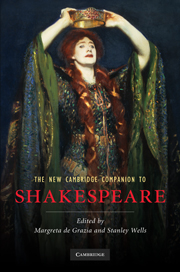Book contents
- Frontmatter
- 1 The traces of Shakespeare’s life
- 2 Shakespeare’s reading
- 3 Shakespeare’s writing: from manuscript to print
- 4 The theatre of Shakespeare’s London
- 5 The transmission of Shakespeare’s texts
- 6 Shakespeare and language
- 7 Shakespeare the poet
- 8 Shakespeare’s comedies
- 9 Shakespeare’s tragedies
- 10 Shakespeare’s English history plays
- 11 Shakespeare’s classical plays
- 12 Shakespeare’s tragicomedies
- 13 Shakespeare, religion and politics
- 14 Shakespeare and race
- 15 Shakespeare, sexuality and gender
- 16 Shakespeare on the stage
- 17 The critical reception of Shakespeare
- 18 Shakespeare and popular culture
- 19 Shakespeare and globalization
- 20 Shakespeare and media history
- 21 Shakespeare: reading on
- Index
2 - Shakespeare’s reading
Published online by Cambridge University Press: 28 January 2011
- Frontmatter
- 1 The traces of Shakespeare’s life
- 2 Shakespeare’s reading
- 3 Shakespeare’s writing: from manuscript to print
- 4 The theatre of Shakespeare’s London
- 5 The transmission of Shakespeare’s texts
- 6 Shakespeare and language
- 7 Shakespeare the poet
- 8 Shakespeare’s comedies
- 9 Shakespeare’s tragedies
- 10 Shakespeare’s English history plays
- 11 Shakespeare’s classical plays
- 12 Shakespeare’s tragicomedies
- 13 Shakespeare, religion and politics
- 14 Shakespeare and race
- 15 Shakespeare, sexuality and gender
- 16 Shakespeare on the stage
- 17 The critical reception of Shakespeare
- 18 Shakespeare and popular culture
- 19 Shakespeare and globalization
- 20 Shakespeare and media history
- 21 Shakespeare: reading on
- Index
Summary
Most of what Shakespeare wrote was played before it was read. The Sonnets are an exception, and Venus and Adonis and The Rape of Lucrece, which he probably saw through the press himself. But for the most part he committed his words to the mouths of actors, and the printers of the quartos and First Folio came later, doing their work sometimes illicitly, then posthumously. Shakespeare was a man of the theatre, not a bookworm. But then again - what performance of Shakespeare is not informed by reading? There is the reading that actors do as they commit scripts to memory. There is the life of reading that literate members of an audience bring to the playhouse. Finally there is what Shakespeare himself read, his sources and influences. That idiosyncratic bibliography - a compost of school text and eight-penny romance and chronicle history - has been painstakingly reconstructed by generations of scholars. But the plays also have a great deal to say about how he read, and what he thought about the whole business of reading. Though reading may be, after sleep, the least dramatic of activities, Shakespeare returns again and again to scenes where a character is perusing a letter or turning a page or brandishing or just talking about a book. The result is a sporadic but career-long meditation on what reading is for.
- Type
- Chapter
- Information
- The New Cambridge Companion to Shakespeare , pp. 15 - 30Publisher: Cambridge University PressPrint publication year: 2010



